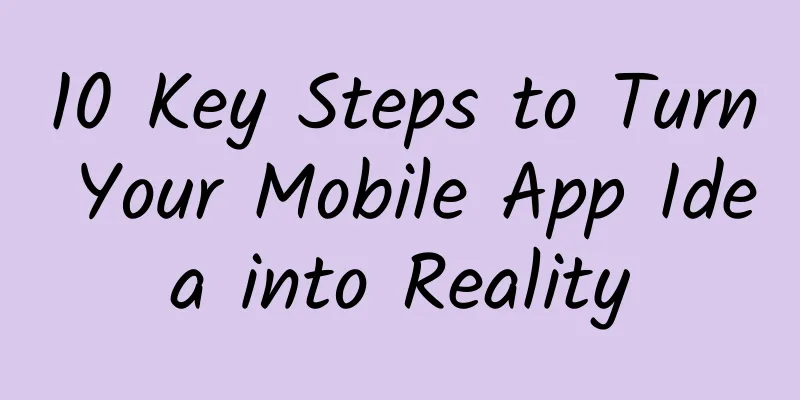10 Key Steps to Turn Your Mobile App Idea into Reality

|
Many individuals and companies come up with new mobile app ideas to occupy or expand the space. They either want to reach new target audiences or provide better services to existing customers. However, relatively speaking, people are not aware of the steps or processes required to turn mobile app ideas into reality. Due to the lack of expertise and information between startups and established companies, most of them do not know how to hone their ideas about apps. I have been helping several companies create their mobile apps. Here are the 10 key steps I have learned from my 6 years of experience. I believe following these steps will surely help anyone in any industry to turn their mobile app idea into reality. Step 1: Write down a list of featuresStart conceptualizing your idea by writing down notes. Before doing anything, you should write down anything that comes to your mind. Having a list of features on paper can help you focus on your idea and expand upon it. I recommend writing down your ideas several times, in many different ways. This list will be very useful when discussing with your co-founders, designers, investors, or developers; they will all ask for this list of features. Please note that you should sign an NDA (non-disclosure agreement) before sharing your feature list with them. The feature list should be clean and easy to understand. Also, make sure to have popular and unique features, which will play a major role in the success of your product. Step 2: Do market researchAfter writing a strong list of features, you need to do market research to identify the competition, trends, and market needs. Make sure there are no similar apps in the market. If there are, check out the reviews, ratings, feedback of these apps, and what is missing. Then, add features to your app to make it unique and more appealing to users. After doing market research, you should update your feature list. Step 3: Identify users/audienceIt is very important to identify who will use the app and who is the audience of the product. The users can be from a specific industry, gender, region, age group, existing customers, income group, specific profession, or any other group. Once you indicate certain demographic characteristics of the audience, you can know what the users of these demographics prefer or like. Knowing the audience helps you redesign your app and its features so that they cater to the needs. The entire project revolves around user engagement. You can also conduct focus group research to understand what the audience may like or dislike. The audience will determine the success of the product, and the insights from the focus group research can define the success of the product to a great extent. Step 4: Determine your monetization strategyMaking money is the biggest reward and incentive. You can earn revenue on your app through several ways: subscription fees, in-app purchases, in-app ads, user data, sponsorships. You need to know which one is right for your app, audience, and market. Releasing a paid app is not right now, but you can make your app free but have in-app purchase options for extra features that your users want. In-app ads are also going out of the mainstream market now because of the user experience factor. User data is becoming a big monetization technique because you can use it to earn indirect money. You can get sponsorship for your app; this works well for apps with a social mission. It is important that you choose 1 or 2 techniques that will give you a good return on your investment. Step 5: Create a Rough Sketch/WireframeYou may not have done this before or may not know how to do it. However, a rough sketch or wireframe helps you define the concept and refine the requirements of the product. You can use paper and pencil to draw a rough sketch, while wireframes can be created using online tools. As you start doing sketches/wireframes, you can further refine the idea and feature list of the app. Also, this helps you decide what kind of navigation will fit the entire app. For this step, you don’t need technical skills, but you do need to have a common sense understanding of how navigation works. The wireframe, along with the feature list, will establish very good specifications for building a mobile app. Step 6: Approach local mobile app developers and get a budgetOnce you have your feature list and initial version of the wireframe, you can start identifying vendors who can build the mobile app in a high-quality and cost-effective manner. You should search for local vendors and some global vendors and contact them. Once you have shortlisted 5 to 6 good vendors, ask them to sign an NDA and send the details of their project. A good vendor should evaluate your details and ask you a lot of questions. You should make sure to answer them in detail so that your ideas can be fully communicated. A good vendor should also be able to provide some suggestions to improve your idea. You should get suggestions from multiple vendors, including the time and cost of development, and compare them. You should evaluate the vendors based on their past performance, process, price, time, proof, and how eager they are to work for you. Finally, you should be able to settle on a vendor and start working with them. Step 7: Finalize UI/UXOnce you have chosen a company, you should work with them to create the UI/UX of the app. First you should create detailed wireframes of the app so that you can visualize each screen, feature, and flow of the app. After reviewing, you can decide to add or remove features. Once the wireframes are complete, you need to have them create the visual design of the app. They should give you their ideas for colors, themes, fonts, and visual appeal. This step will give you the final version of how your mobile app will look and flow. Once you are done, ask the vendor to re-evaluate the development schedule, time, and cost. If the initial estimated time/cost has increased, then be prepared to pay more or reduce some features. Pay the mobile app developer a fair value. Step 8: Get the developed and tested appAsk your app developer to start creating the app for you. They should be able to send you the app every week (work in progress) and you should test it and give them feedback. It is essential for you to QA the app while developing as this will help you control the quality, cost, and timeline and understand if the mobile app needs some tweaks. You can also ask your friends to participate in the testing. If you come up with new features during the development process, discuss them with the app developer and get an estimate of the time and cost. If it fits the budget, complete it immediately. If not, wait for the next stage. Step 9: Release and market your appOnce you are happy with the app, then publish it in the iTunes App Store and Google Play Store. You should start marketing the app. You can get some advice from app marketing experts. You can also market it yourself. Start with Facebook, Twitter, and Instagram, as this is an easy way to spread the word about the app. You should also contact journalists and bloggers who might be interested in the app and write blog posts about it. It is also very convenient to write press releases on free or paid websites. If you have a bigger budget, you can also hire a PR or app marketing company. Step 10: Collect market response and prepare for the next phaseAfter the initial launch and marketing, you can collect user data, market response, and demand. If the response you receive is good, then you can plan the next phase of the app. The next phase is to repeat steps 1 to 9. This time, you should be able to do it faster and more efficiently. If the app does not have a good response in the market, then find out what is hindering growth and make an action plan. |
<<: Android nested sliding mechanism NestedScrolling
>>: Aiti Tribe Stories (1): How a rookie transformed into a senior programmer
Recommend
Another wave of respiratory infections coming? What to do if you test positive for Streptococcus pneumoniae?
"I avoided mycoplasma and influenza, but was...
Tips for placing advertising video content on Tik Tok!
This article takes the education industry as an e...
Yang Zhenning: A driving force behind Sino-US scientific and technological exchanges and cooperation
Yang Zhenning is one of the most influential theo...
Why should you be careful of large livestock when driving to pastoral areas?
This article was reviewed by Chen Xiaokai, Associ...
My knees make a "cracking" sound when I squat. Is there something wrong with my joints?
Netizen asked: I am 25 years old. When I squat an...
How much does it cost to be a Ningbo Electrical Mini Program agent? What is the quote for Ningbo Electrical Mini Program Agent?
How much does it cost to be a Ningbo Electrical M...
Xiaomi App Store CPD Cooperation Introduction
1. Platform Introduction 1. Service Introduction ...
Yiche: Ranking of hard-core off-road vehicle sales from January to August 2024 and August: Tank 300 sales volume was 52,466 units
Since the launch of the Tank 300, domestic consum...
The most undesirable bug in Android: fix is nowhere in sight
Android 5.1 has been pushed to many Nexus devices...
What's a good gift to give to girls on 520? What gift should I give to a girl?
The romantic 520 is a holiday that every girl lik...
Add WeChat to receive Taobao customer operation materials worth 4980 for free!
Dear Taobao friends, if you are still worried abo...
APP information flow advertising: creative features and data analysis of promotional materials
The rapid development of mobile Internet has prom...
Heisenberg’s student, Yang Zhenning’s mentor: Is he a genius or a paranoid?
Edward Teller, this genius physicist, has both go...
The original site of the overpass that disappeared for nearly 90 years has finally seen the light of day again. How was it discovered and found?
Beijing's Central Axis, an axis that carries ...
Payment logic: Why should users give you money?
In this world, it is not easy for a person to mak...









